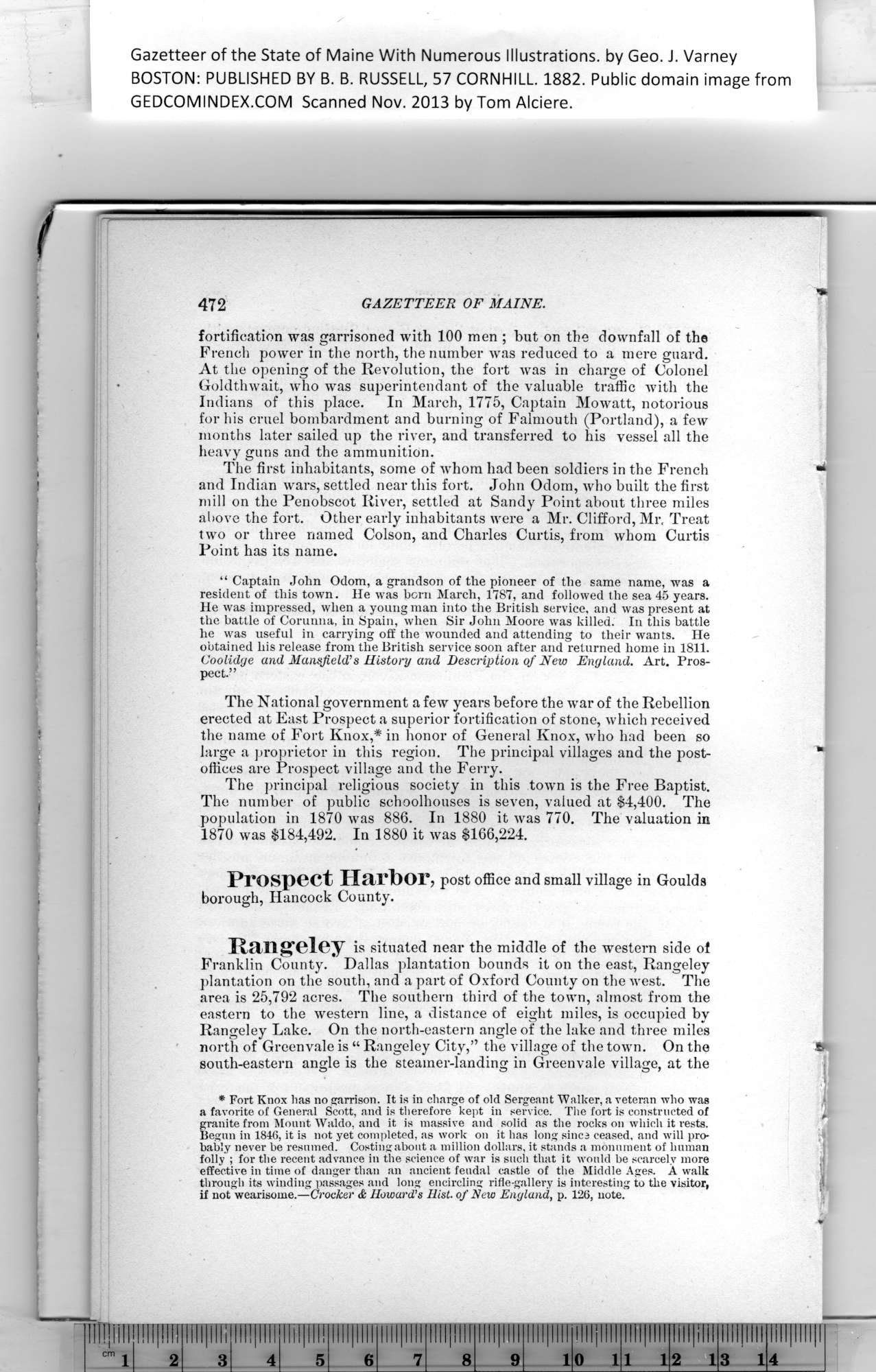|
Gazetteer of the State of Maine With Numerous Illustrations, by Geo. J. Varney
BOSTON: PUBLISHED BY B. B. RUSSELL, 57 CORNHILL. 1882. Public domain image from
472 GAZETTEER OF MAINE.
fortification was garrisoned with 100 men ; but on the downfall of the
French power in the north, the number was reduced to a mere guard.
At the opening of the Revolution, the fort was in charge of Colonel
Goldthwait, who was superintendant of the valuable traffic with the
Indians of this place. In March, 1775, Captain Mowatt, notorious
for his cruel bombardment and burning of Falmouth (Portland), a few
months later sailed up the river, and transferred to his vessel all the
heavy guns and the ammunition.
The first inhabitants, some of whom had been soldiers in the French 1
and Indian wars, settled near this fort. John Odom, who built the first
mill on the Penobscot River, settled at Sandy Point about three miles
above the fort. Other early inhabitants were a Mr. Clifford, Mr. Treat
two or three named Colson, and Charles Curtis, from whom Curtis
Point has its name.
“ Captain John Odom, a grandson of the pioneer of the same name, was a
resident of this town. He was born March, 1787, and followed the sea 45 years.
He was impressed, when a young man into the British service, and was present at
the battle of Corunna, in Spain, when Sir John Moore was killed. In this battle
he was useful in carrying off the wounded and attending to their wants. He
obtained his release from the British service soon after and returned home in 1811.
Coolidge and Mansfield?s History and Description of New England. Art. Pros-
pect.”
The National government a few years before the war of the Rebellion
erected at East Prospect a superior fortification of stone, which received
the name of Fort Knox,2 in honor of General Knox, who had been so
large a proprietor in this region. The principal villages and the post- *
offices are Prospect village and the Ferry.
The principal religious society in this town is the Free Baptist.
The number of public schoolhouses is seven, valued at $4,400. The
population in 1870 was 886. In 1880 it was 770. The valuation in
1870 was $184,492. In 1880 it was $166,224.
Prospect Harbor, post office and small village in Goulds
borough, Hancock County.
Rangeley is situated near the middle of the western side of
Franklin County. Dallas plantation bounds it on the east, Rangeley
plantation on the south, and a part of Oxford County on the west. The
area is 25,792 acres. The southern third of the town, almost from the
eastern to the western line, a distance of eight miles, is occupied by
Rangeley Lake. On the north-eastern angle of the lake and three miles
north of Greenvale is “ Rangeley City,” the village of the town. On the !►
south-eastern angle is the steamer-landing in Greenvale village, at the
1
Begun in 1846, it is not yet completed, as work 011 it has long since ceased, and will pro-
bably never be resumed. Costing about a million dollars, it stands a monument of human
folly ; for tbe recent advance in the science of war is such that it would be scarcely more
effective in time of danger than an ancient feudal castle of the Middle Ages. A walk
through its winding passages and long encircling rifle-gallery is interesting to the visitor,
if not wearisome.—Crocker & Howard’s Hist, of Hew England, p. 126, note.
2
Fort Knox lias no garrison. It is in charge of old Sergeant Walker, a veteran who was
a favorite of General Scott, and is therefore kept in service. The fort is constructed of ,
granite from Mount Waldo, and it is massive and solid as the rocks on which it rests.
PREVIOUS PAGE ... NEXT PAGE
This page was written in HTML using a program written in Python 3.2
| 